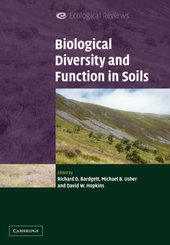
|
Biological Diversity and Function in Soils
Paperback / softback
Main Details
| Title |
Biological Diversity and Function in Soils
|
| Authors and Contributors |
Edited by Richard Bardgett
|
|
Edited by Michael Usher
|
|
Edited by David Hopkins
|
| Series | Ecological Reviews |
|---|
| Physical Properties |
| Format:Paperback / softback | | Pages:428 | | Dimensions(mm): Height 244,Width 170 |
|
| Category/Genre | Ecological science
Applied ecology |
|---|
| ISBN/Barcode |
9780521609876
|
| Classifications | Dewey:577.57 |
|---|
| Audience | | Professional & Vocational | |
|---|
| Illustrations |
9 Halftones, unspecified; 78 Line drawings, unspecified
|
|
Publishing Details |
| Publisher |
Cambridge University Press
|
| Imprint |
Cambridge University Press
|
| Publication Date |
22 September 2005 |
| Publication Country |
United Kingdom
|
Description
Soil has generally been regarded as something of a 'black box' by ecologists. The importance of soil is obvious: it provides physical support for plants, and both the living and non-living components contribute to a variety of important environmental functions. Soil is a species-rich habitat, but many questions about the ecological significance of the soil's biological diversity, and in particular how it affects ecosystem function, have never been asked. The linkages between above-ground ecology, which is rich in ecological theory, and below-ground ecology, where investigation has been restricted by methodological difficulties, have not been made. Recent technical developments, including isotopic and molecular methods as well as new experimental and modelling approaches, have led to a renaissance in soil biodiversity research. The key areas are reflected in this exciting new volume, which brings together many leading contributors to the new understanding of the role and importance of soil biota.
Author Biography
RICHARD D. BARDGETT is Professor of Ecology at Lancaster University and has published widely on plant-soil interactions, nutrient cycling, and soil ecology. He is especially interested in studying linkages between plant and soil biological communities, and examining how these links are affected by herbivores. MICHAEL B. USHER is retired. For more than 40 years he has had a research interest in the soil biota, especially the Collembola (springtails), Isoptera (termites) and Mesostigmata (mostly predatory mites). He also has a strong interest in nature conservation, and is currently working on a number of aspects of the conservation of biodiversity. DAVID W. HOPKINS is Professor of Environmental Science at the University of Stirling and has research expertise in soils science and ecology, especially the biology and biochemistry of nutrient cycling. His research involves ecological, environmental and archaeological projects.
Reviews'... the contributions are well written and come up with new views and perspectives. ... the book is very well edited and includes a comprehensive index allowing quick location of topics. ... the editors are to be congratulated for having brought together some of the most prominent in the field for contributing to this volume. ... Certainly, the new book will substantiate the appreciation of the importance of the below-ground system and I wish it will be read not only by people working on soil biota but by a wide audience of ecologists including those working on above-ground systems.' Basic and Applied Ecology 'This is an excellent reference book that provides information on soil eco-system functioning which will be useful to a wide range of readers from undergraduates to researchers. The great subject breadth contains a lot of very useful information for both the specialist and those wishing to extend their knowledge into other areas. Non-specialists will find this a very good introduction to soil biology as it informs just how diverse, active, potent and intriguing soil systems are. A text to be recommended.' Experimental Agriculture 'It offers a clear, often brilliant demonstration that the knowledge of soil biodiversity is the key for the sustainable management of terrestrial ecosystems.' European Journal of Soil Science
|